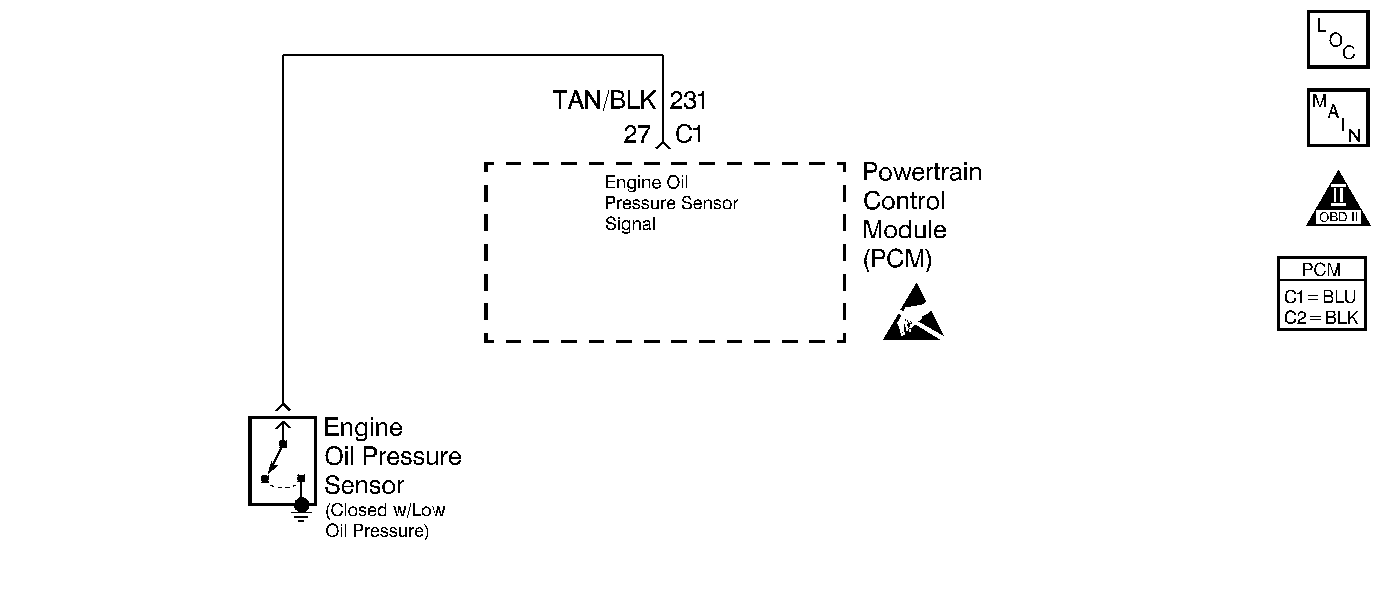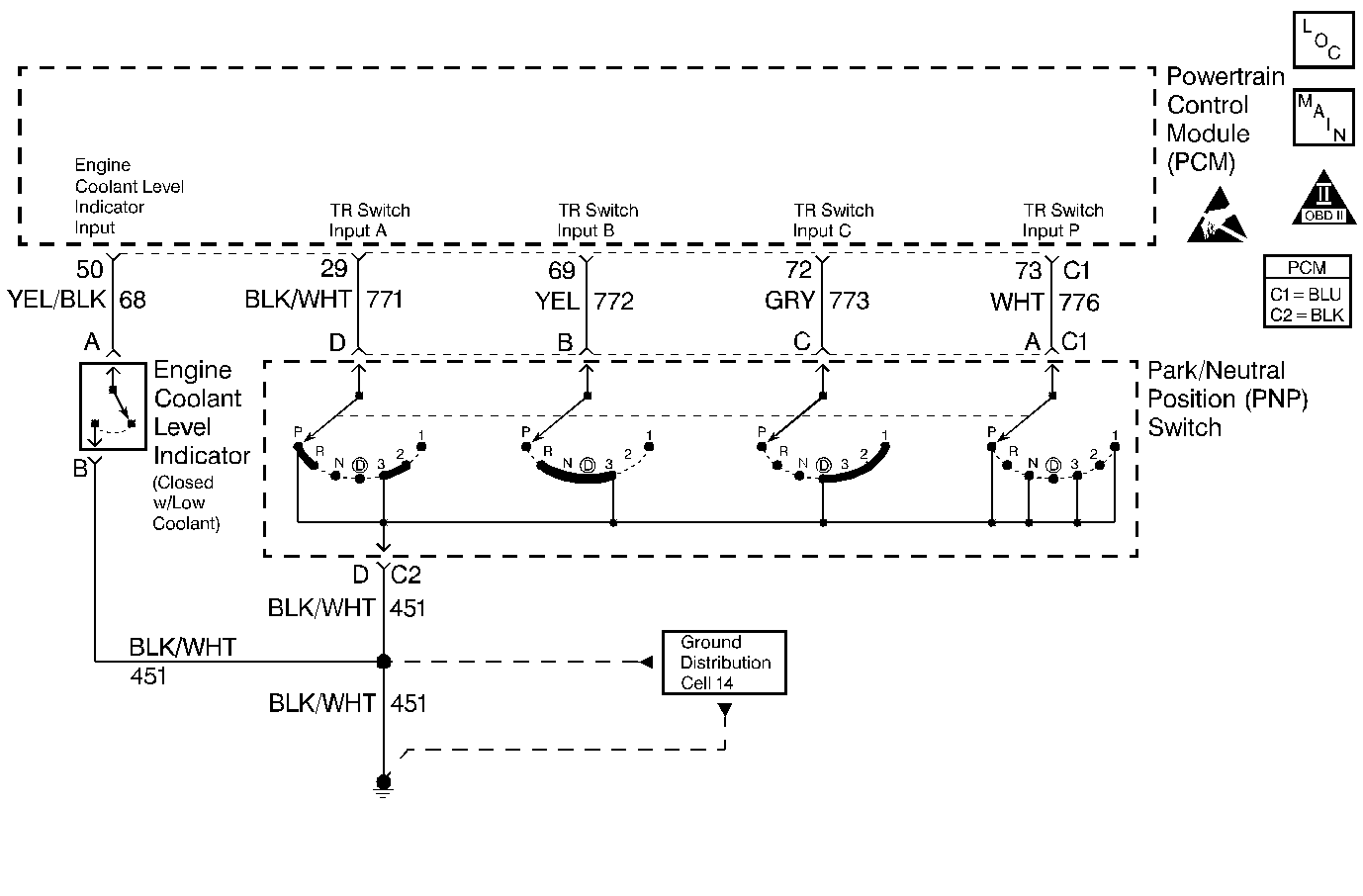Powertrain Control Module Controlled Warning Lamps Diagnosis Engine Oil Pressure switch

Diagnosis
| • | The following tables will diagnose the oil pressure switch and the coolant level switch circuits. |
| • | For diagnosis of the Instrument Panel Cluster (IPC), refer to Section 8A and Section 8C1 . |
| • | For PCM replacement information, refer to Powertrain Control Module/EEPROM Replacement/Programming . |
Circuit Description
The engine oil pressure indicator switch indicates low engine oil pressure. The oil pressure indicator switch has normally closed contacts that open when oil pressure is greater than 41 kPa (6 psi). The contacts will close when oil pressure is less than 14 kPa (2 psi). When the contacts are closed, the oil pressure signal is sent to the Powertrain Control Module (PCM). The PCM then sends this signal to the Instrument Panel Cluster (IPC) through to illuminate the oil pressure telltale lamp on the IPC.
Diagnostic Aids
| • | Low oil level or low oil pressure at times may be caused by an engine mechanical problem. If a low oil pressure problem is suspected, refer to the Engine Mechanical portion of the service manual. |
| • | An Intermittent problem may be caused by a poor connection, rubbed through wire insulation, or a wire that is broken inside the insulation. |
| • | Any circuitry, that is suspected as causing the intermittent complaint, should be thoroughly checked for the following conditions: |
| - | Backed out terminals |
| - | Improper mating |
| - | Broken locks |
| - | Damage to the wiring harness |
Test Description
Number(s) below refer to the step number(s) on the Diagnostic Table.
-
The Powertrain OBD System Check prompts the technician to complete some basic checks and store the freeze frame and failure records data on the scan tool if applicable. This creates an electronic copy of the data taken when the fault occurred. The information is then stored on the scan tool for later reference.
-
This step is crucial to prevent possible engine damage due to a low oil condition.
-
The PCM senses when the oil pressure signal is pulled low by the oil pressure switch. This step will determine if the PCM is able to sense the signal.
-
When the oil pressure is low, the signal circuit is grounded through the oil pressure switch. This step will determine if the signal is grounded because of the oil pressure switch or a short to ground.
-
The PCM uses a voltage signal to sense when the oil pressure circuit is pulled low. This step will determine if battery voltage was on this circuit normally or because of a short. When the signal circuit is probed by a test light connected to ground, the oil pressure symbol will illuminate.
-
If an oil pressure problem is suspected, do not run the engine longer than necessary to avoid possible internal engine damage.
-
Refer to Section 8C1 for Instrument Panel Cluster (IPC) replacement.
-
Reprogram the replacement PCM. Perfrom the crankshaft position system variation procedure. Refer to the latest Techline procedures for PCM reprogramming and the Crankshaft Position System Variation Procedure.
-
If no malfunction have been found at this point, refer to Diagnostic Aids for additional checks and information.
Step | Action | Value(s) | Yes | No |
|---|---|---|---|---|
Was the Powertrain On-Board Diagnostic (OBD) System Check performed? | -- | |||
Check the engine oil level. Is the engine oil level OK? | -- | |||
3 | Was a DTC P1601 set? | -- | ||
4 | Turn the ignition switch ON, with the engine OFF. Does the engine oil pressure telltale lamp illuminate and stay illuminated? | -- | ||
5 | Add engine oil. Is the action complete? | -- | -- | |
6 | Start the engine. Is the oil pressure telltale lamp illuminated? | -- | ||
Does the DVM read the specified value? | B+ | |||
Does the test light illuminate? | -- | |||
With a test light connected to ground, probe the oil pressure signal circuit. Does the test light illuminate? | -- | |||
10 | Check for a poor connection or an open in the oil pressure signal circuit and repair as necessary. Was a repair necessary? | -- | ||
11 | Repair the short to ground in the oil pressure signal circuit. Is the action complete? | -- | -- | |
12 |
Does the scan tool indicate low oil pressure? | -- | ||
13 | Install a scan tool. Does the scan tool indicate low oil pressure? | -- | ||
14 | Repair the short to B+ in the oil pressure signal circuit. Is the action complete? | -- | -- | |
Check for a basic engine problem causing low oil pressure (refer to Section 6A ) and repair as necessary. Was a repair necessary? | -- | |||
Replace the IPC. Is the action complete? | -- | -- | ||
17 | Check for a poor connection in the oil pressure signal circuit and repair as necessary. Was a repair necessary? | -- | ||
18 | Replace the engine oil pressure switch. Is the action complete? | -- | -- | |
Replace the PCM. Is the action complete? | -- | -- | ||
Operate vehicle within the conditions under which the original symptom was noted. Does the system now operate properly? | -- | System OK Refer to Diagnostic Aids |
Powertrain Control Module Controlled Warning Lamps Diagnosis Coolant LeveL Switch

Diagnosis
| • | The following tables will diagnose the oil pressure switch and the coolant level switch circuits. |
| • | For diagnosis of the Instrument Panel Cluster (IPC), refer to Section 8A and Section 8C1 . |
| • | For PCM replacement information, refer to Powertrain Control Module/EEPROM Replacement/Programming . |
Circuit Description
The coolant level switch is an assembly containing a reed switch and magnetic float. When the coolant level is normal, the float rests away from the reed switch, causing the switch to open. When the coolant level is low, the float rests near the reed switch and the switch closes.
The coolant level switch is mounted in the radiator surge tank. If the coolant level falls below a specified level, the switch closes sending a ground signal to the Powertrain Control Module (PCM). The PCM will then send this signal to the instrument panel cluster (IPC). The IPC will then illuminate the low coolant level telltale lamp.
Diagnostic Aids
| • | Quick Test: Disconnect the coolant level switch electrical connector. With a test light connected to ground, probe the signal circuit. This will cause the coolant level indicator to turn ON if the wiring, PCM and IPC are OK. |
| • | An Intermittent problem may be caused by a poor connection, rubbed through wire insulation. |
| • | Any circuitry, that is suspected as causing the intermittent complaint, should be thoroughly checked for the following items: |
| - | Backed out terminals |
| - | Improper mating |
| - | Broken locks |
Test Description
Number(s) below refer to the step number(s) on the Diagnostic Table.
-
The Powertrain OBD System Check prompts the technician to complete some basic checks and store the freeze frame and failure records data on the scan tool if applicable. This creates an electronic copy of the data taken when the fault occurred. The information is then stored on the scan tool for later reference.
-
The coolant level switch cannot be removed from the surge tank. Draining the coolant from the tank will check if the switch can detect an empty tank and also check the PCM and wiring.
-
A test light is used to determine if the coolant level telltale lamp is remaining ON because of a shorted signal circuit, a malfunctioning PCM, or a malfunctioning IPC. If the test light is ON, then the signal circuit is shorted to ground.
-
This simulates a normal coolant level. If the telltale lamp turns OFF when the coolant level switch is disconnected, then the PCM, the IPC and the wiring are OK.
-
The PCM uses a voltage signal to sense when the coolant signal circuit is pulled low by the coolant switch. If voltage is not present on this the signal circuit, then the circuit is open, or connections or the PCM are malfunctioning.
-
This will determine that the battery voltage seen on the signal circuit was from the PCM and not a wire shorted to voltage.
-
The PCM sends coolant level information through serial data to the IPC. If the scan tool indicates a low coolant level when the coolant level switch electrical connector disconnected, then the PCM is malfunctioning.
-
Reprogram the replacement PCM. Perfrom the crankshaft position system variation procedure. Refer to the latest Techline procedures for PCM reprogramming and the Crankshaft Position System Variation Procedure.
-
If no malfunction have been found at this point and no additional DTCs were set, refer to Diagnostic Aids for additional checks and information.
Step | Action | Value(s) | Yes | No |
|---|---|---|---|---|
Was the Powertrain On-Board Diagnostic (OBD) System Check performed? | -- | |||
2 | Was a DTC P1601 set? | -- | ||
3 | Turn the ignition switch ON, with the engine OFF. Did the coolant level telltale lamp on the instrument panel cluster turn ON for about 3 seconds and then turn OFF? | -- | ||
Drain the coolant from the surge tank. Did coolant level telltale on instrument panel cluster turn ON? | -- | |||
5 | Check the coolant level in the surge tank. Is the coolant level OK? | -- | ||
Does the test light illuminate? | -- | |||
Disconnect the coolant level switch electrical connector. Is the coolant level indicator lamp illuminated? | -- | |||
8 | Fill the surge tank. Is the action complete? | -- | -- | |
With a DVM connected to ground, probe the coolant level switch signal circuit. Does the DVM read the specified value? | B+ | |||
10 | Repair the poor connection or open coolant level switch ground circuit. Is the action complete? | -- | -- | |
11 | With a test light connected to B+, probe the coolant level indicator switch signal circuit. Does the test light illuminate? | -- | ||
With a test light connected to ground, probe the coolant level indicator switch signal circuit. Does the test light illuminate? | -- | |||
13 | Check for a poor connection or open coolant level switch signal circuit and repair as necessary. Was a repair necessary? | -- | ||
14 | Check for a short to ground in the coolant level switch signal circuit and repair as necessary. Was a repair necessary? | -- | ||
Install a scan tool. Is the coolant level indicated as low? | -- | |||
16 | Check for a short to B+ in the coolant level switch signal circuit and repair as necessary. Was a repair necessary? | -- | ||
17 | Replace the engine coolant level switch. Is the action complete? | -- | -- | |
18 | Replace the IPC. Is the action complete? | -- | -- | |
Replace the PCM. Is the action complete? | -- | -- | ||
Operate vehicle within the conditions under which the original symptom was noted. Does the system now operate properly? | -- | System OK Refer to Diagnostic Aids |
